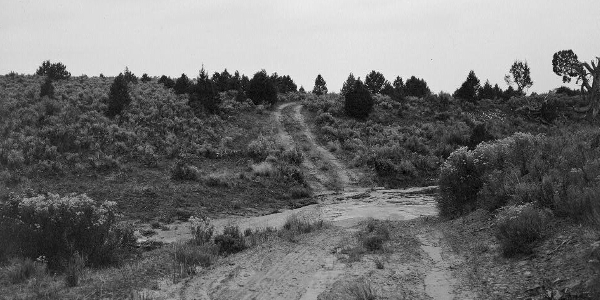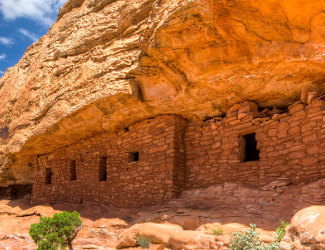
Above photo: Sixshooter peaks above Indian Creek Canyon. Courtesy Bureau of Land Management. Right: Close up view of the Bears Ears. Both courtesy Bureau of Land Management.

Bears Ears National Monument
Let's start off first with the obvious. Designation of the new national monument centered around the Bears Ears buttes by President Barack Obama on December 28, 2016 was controversial. With one stroke of his pen using the 1906 Antiquities Act, the President changed the uses and preservation status of over 1.3 million acres. Many in the region and around the United States applauded the designation, saving the heritage and history of the tribal lands. Many eschewed the designation as government overreach and taking available land away from other uses. The discussion on just what shape and size the monument will take is still ongoing, as well as what visitor amenities will be added and are appropriate, but the fact of its historic vistas and important heritage, thousands of years to take shape, has not changed.
Sponsor this page. Your banner or text ad can fill the space above.
Click here to Sponsor the page and how to reserve your ad.

Bears Ears Then
The significance of the archaeological and heritage sites, plus the religious import that the Bears Ears buttes and other locations within the park hold to the tribes of the area, is hard to enumerate. The cliff dwellings themselves of the Ancestran Puebloan people reach back over three thousand five hundred years. How many archaeological sites are within its current borders? One hundred thousand. And some of the history here goes back to the Clovis people. Oh, those Clovis. Only thirteen thousand years ago did they hunt in Cedar Mesa within the park.
Mormons and the United States - The lands were purchased by the United States in the Treaty of Guadalupe Hidalgo in 1848. Twelve years later the Navajo tribes there were compelled to leave. Some hid in the canyons and caves, refusing to leave. In 1880, the Mormons arrived, two hundred and thirty of them, traveling over the Hole in the Rock Trail to their settlement in Bluff, Utah at today's southeast corner of the park. The trail is still there; some of it now an upaved road.
Photo above: Hole in the Rock Trail from Bluff, San Juan County to Escalante, 1907, Historic American Buildings Survey. Courtesy Library of Congress. Photo below: Roads leading through the park. Courtesy Bureau of Land Management.

Bears Ears Now
After the 2016 proclamation, the acreage and historic sites of the monument are jointly managed by the Bureau of Land Management and the United States Forest Service. It's the fifth such park co-managed by those two branches. They, and partners in the tribal communities, are currently undergoing a management plan process to see what visitor amenities will be available. This is an ongoing process and problematic with the current uncertainty about what lands will be included.
Designation of the national monument was agreed to and acknowledged by the five main tribes of the region; Hopi, Navajo, Ute Mountain Ute, Zuni, and the Ute Indian Tribe of the Uinta Ouray. They consider it an important step to protect their ancestral grounds and heritage sites.
T-Shirts and Souvenirs

Save Bears Ears National Monument t-shirts, bumper stickers, and other items.

Bears Ears
Things You Should Not Miss
1. Bears Ears Monument, at least for now, is a vast place with opportunities to fish, hunt, and nature gaze at every corner. Take advantage of the pastime of your choice.
2. Take in a Hole in the Rock trail walk or ride. You'll be traveling on the path of Mormon pioneers. Beware, at places it's pretty rugged. Other places, it's a road.
3. Take a drive. It's probably the best way to see the massive amounts of nature and history here. Go to the Needles and Anticline Overlook. It's off Highway 191, 32 miles south of Moab. If you're down south near Bluff, Utah, head three miles west to the Sand Creek Recreation Area. You'll get to see the Sand Island petroglyphs and ruins of the San Juan River House.
Photo above: Cliff dwelling in the rocks of Bears Ears National Monument. Courtesy Bureau of Land Management.




